
Guide to the Larp
Foreword
Welcome to the guide to the Larp “Sahara Expedition – In Search for the Unknown”! Here you will find all the information you need to participate and enjoy this incredible experience. If you have any doubts or questions after reading it, please contact us!!
Living document
This guide may be updated with new content in the coming weeks. Whenever this happens, we will communicate this on our channels (Facebook, mailing list, WhatsApp, Discord).
Disclaimer
The setting of the game is inspired by H.P. Lovecraft’s Cthulhu cycle. However, we reject his racist ideas and claim a modern approach to a fictional universe that is everyone’s heritage. We will present a critical interpretation of the Cthulhu Mythos and 20th century society. Madness will not be the stereotypical representation of existing mental disorders but will be connected to the cosmic horrors typical of the setting. The larp is not a celebration of the colonial season and exoticism. On the contrary, it will be respectful and written with the maturity we put into each of our works.
General Info
Sahara Expedition is about the daily life of an expedition in the desert, the tasks each must perform to find the legendary Zerzura and the traces of the previous Jefferson Expedition.
It is the story of adventurers in search of a hidden and ancient truth, confronting their fears and ambitions. It is a human story about desires, power, mysteries; the story of a legendary quest, both within and outside ourselves.
Location: Douz, Sahara Desert, Tunisia
Meeting Point: 10:00 Tunis Clock Tower for the bus transfer towards the oasis of Douz
Partecipanti: 78 per run
Programme
Day 1
10:00 – Meeting at the Tunis Clock Tower and Departure for the oasis of Douz by bus
Dinner and overnight stay in a 4* category hotel
Day 2
10:00 – Workshop (Hotel) and Prologue of the Larp (Hotel)
Day 3
10:00 – Larp (Hotel + Desert)
Day 4
Larp + final party in the desert
Day 5
Departure to Tunis Clock Tower (expected arrival 7 p.m. approx.).
(OPTIONAL) Additional Tunisia Tour
Extend your trip and discover the wonders of Tunisia. We have great options.
Warning
Keep in mind that there may be inconveniences and mishaps beyond our control (traffic, road works, various unforeseen events). Also, as most of the participants will be taking intercontinental flights, check-in at the airport can take several hours. For this reason, we recommend, if possible, booking flights that leave at a convenient time.
Workshop
Prior to the start of the larp, a series of workshops are planned with the aim of:
- Becoming familiar with the game themes and setting.
- Getting to know the other players, especially those you interact with most, and agreeing on how to interact with the various characters.
- Understanding how to play your own character.
- Learning the metatechnics.
- Clarifying any unresolved doubts.
The workshop will be an important opportunity to agree on the rules of the game and have a few tryout interactions.
Game Experience
This larp focuses on the life of a caravan, the daily hardships, the tasks each must perform and the aims of a momentous mission. A human story of desire, power, hate and love. The story of a gruelling quest, within and outside ourselves. We will live the life of a real expedition in which everyone will have their own role and duties: soldiers, politicians, artists, explorers, scientists, adventurers and more.
We have chosen to bring the dimension of exploration to life as something concrete and real, not just as a ‘fake’ backdrop, like a cardboard set. Technical challenges, research, caravan movements, scientific research missions and much more will be an integral part of the gaming experience. A larp we imagined as real, deep, exciting.
Choose your own gaming experience
In Sahara Expedition you will find different game experiences depending on the character you choose and the Institution to which they belong. Some narrative lines will be more interpretive, others more investigative, others more practical or action-oriented – although there will be no actual combat.
You will be able to choose whether to throw yourself into daring research or engage in social play. In addition, conflicts and friendships between characters will animate the game, adding emotional depth to your play. Larp is based on three basic strands: Expedition, Psychological Horror and Intrigue & Relationships.
The Expedition
An important part of the gaming experience concerns the daily life of the Sutton-Gudrian archaeological expedition, immersed in the extraordinary scenery of the Sahara Desert. The expedition will consist of four main institutions that will take care of various tasks necessary for the success of the mission.
Each character will have one or more tasks to perform that will be impactful to the success and survival of the expedition (no actual experience is required for the tasks). Each character is an essential piece of the mosaic. During their tasks, characters will have the opportunity to interact with other participants, to face and solve puzzles, to explore the fascinating desert setting, and to show off their character.
Trekking
Every day, the caravan proceeds on its journey on foot with the help of camels to carry the luggage.
It will not be a very long and exhausting walk, but expect to march (and play during the march) for about an hour on the first day and about 2-3 on the second.
For this reason, we recommend that you wear comfortable clothes and shoes (see the chapter on costumes).
In short:
- The daily procedures of the expedition are a fundamental part of the game experience.
- They are designed to increase immersiveness in the scenario and setting and allow you to explore relationships with other characters.
Cosmic and Psychological Horror
In Sahara Expedition – In Search for the Unknown the horror and supernatural elements are treated in a nuanced manner, just like in the tales of the Cthulhu cycle. Our approach to horror is more intimate and psychological than splatter or visual. You won’t find monsters to fight, but a horror that comes from afar, too big and fearsome for fragile human minds to comprehend.
The atmospheres we love in the stories related to the Cthulhu Mythos are those in which horror becomes cosmic and in which, through the courage of a cultured professor, a shy librarian or a curious adventurer, we are shown the true texture of reality, in which our entire conception of the world is turned upside down. Think about it, the protagonists of these stories are never heroes, they are people who have to come to terms with the narrowness of their condition. They are almost always destined to die, go mad or achieve a victory that they know is ephemeral.
This is exactly the feeling you will find in Sahara Expedition. The style inspired by Lovecraft’s most mature and terrifying works (The Colour out of Space, The Mountains of Madness, The Call of Cthulhu, The Mask of Innsmouth). A realistic, profound, exciting larp.
In short
- Cosmic and psychological horror, not splatter or visual.
- The characters are fragile and human. There are no heroes.
- Victory against cosmic horror, in the long run, is impossible.
- There are no monsters to fight.
Intrigues and relationships
In Sahara Expedition you will find different game experiences. Without risk of spoiling the surprise, we can say that the larp will have intrigue, mysteries, puzzles to solve and choices to make, linked to the characters’ past and present.
You can always choose to throw yourself into daring quests or engage in social play. Furthermore, conflicts and rivalries will animate the game, adding emotional depth to your daily routine. Each character will also be linked to different social groups which will help you relate collaboratively with other players by increasing the possibility of being the master of your own story, accepting others’ cues and offering your own.
In short
- The main story is related to the expedition, but there are many others.
- It is essential to collaborate with others in order to uncover secrets and share information.
What you will not find
In Sahara Expedition you will find no fighting, no physical confrontation. These themes are far removed from the stories of the Cthulhu Mythos we want to tell. There will be no monsters to fight: this is not a live-action version of the role-playing game ‘The Call of Cthulhu’.
In Sahara Expedition you will find no real scarcity of water or food. You will always be able to eat and drink enough (and plenty!).
Sahara Expedition is not a competitive larp where you can win or lose. The aim of the game is to experience a wonderful story together with other people. There is no competition, no winner. Just people creating a beautiful narrative together.
In short
- This is not a competitive larp.
- There will be no fighting or physical confrontation.
- There will be no shortage of water or food.
- Collaborate with other participants in the creation of the story.
Game Style
We have put together a short list of tips. Playing by following these tips will help you have a better gaming experience!
Play Generously
Give space to the others, help them in the development of their story arc.
Play On The Details
Enjoy those little details that can make your larp great: a glance during a task at hand, a clandestine meeting behind a dune at midnight, a gesture of understanding…
Make The Wrong Choices
Imagine you are a character in a Cthulhu Mythos tale. You would not be a fearless hero, but a ‘normal’ person in the face of unbeatable cosmic horror. Madness and death may be your destiny, and that is perfectly fine. The design of the game or your story line may lead you to make choices that are rash, harmful or that you would not make in real life.
If this is the case, do NOT fight it, there is no horror story without protagonists doing the wrong thing. Remember that THERE IS NO WINNING in this larp. The best thing you can do is to follow your character.
Follow The Game Pillars
Outside of the life of the Expedition, the moments of horror, and the intrigue and relationships between the characters, there are NO OTHER game pillars.
This is not the kind of larp where you can create other game poles (sabotaging the expedition, hiding artefacts, running away).
Follow the Game Rythms
The day of the Expedition has rhythms and appointments marked by the procedures and decisions of the Mission Command. They are meant to ensure both the development of the narrative and the development of social relationships. Procedures are an obligatory and vital part of the gameplay, they serve to regulate the functioning of the Expedition and to make it move forward. Remember that no skills are required for any role, all procedures will be explained during the workshops. There will also be free play in which you can express your character and their relationships.
We hold a few principles dear:
- Sahara Expedition is a great shared narrative, a story that you create TOGETHER with other players, NEVER AGAINST.
- Listen to the other players.
In short
- Make the wrong choices, follow your character and the feeling of the tales of the Mythos. Winning is not an option.
- Follow the game: expedition life, investigation and horror.
- Follow the game’s rhythms and procedures and participate in what happens during the day.
Safety
Our events are safe and inclusive. We believe in a community that embraces diversity and rejects any form of discrimination based on gender, ethnicity, faith, sexual orientation, physical ability, and any other aspect of people’s identity. There is no room for verbally or physically abusive behaviour at our events and anyone behaving inappropriately will be removed.
Sahara Expedition is an accessible and inclusive experience, but also an opportunity to address important issues. We believe that every character and every story should have a connection to the reality that surrounds us, with its lights and shadows. And we believe that larp can be a safe space for exploration and reflection.
That is why in Sahara Expedition you will not only find all the typical themes of the Cthulhu Mythos but also a critical reflection on the horrors of 20th century human history. Oppression, discrimination and persecution of the different and minorities are part of the background of some characters. It is up to each player to decide to play on these themes if they find them interesting and appropriate to their sensibilities, or to keep them muted if they do not feel comfortable with them. These themes are geared towards providing a deeper and less stereotypical experience of the setting and may under no circumstances be used to impede anyone’s play.
For this reason, for example, it will be perfectly normal to have a woman as head of the Legion or LGBTI+ and BIPOC professors. A part of the workshop before the game will be dedicated to this topic and the calibration of the themes. Furthermore, the typical madness of this fictional universe (the Descent) will not be a stereotypical representation of existing mental disorders but will be connected to the abysmal horrors of the setting.
During the event a Safety Team of experienced, reliable and empathetic people will always be available to offer assistance and to support you in managing your emotional wellbeing and to provide practical advice on how best to develop your gaming experience.
During the event you will always be able to stop and find a quiet space in which to relax.
There will be game mechanics to emotionally and physically protect all participants. In addition, part of the initial workshops will focus specifically on this. Moreover, during the entire stay in the desert, there will be qualified medical personnel on hand to assist with any medical needs. If you have any doubts or questions, please contact us.
For the good of the game and the participants, the organisers also reserve the right to remove players whose behaviour is disturbing or annoying. In this case the player will be accompanied to the hotel where they will be able to stay at their own expense until the end of the game.
In short
- Any gender discrimination will not be part of the game dynamics. However, discrimination and persecution outside the Expedition may be part of the background of some characters.
- During the event there will be a safety team to offer support and back you up.
- There will be specific mechanics to opt out of situations where you do not feel comfortable during the game (these will be shown in the workshops).
Setting
The year is 1934. Europe is swept by the cold current of totalitarianism and the horror of World War II is slowly brewing, while that of World War I, the Great War for our characters, is still in the eyes and in the flesh of many. These are years when spiritualism arouses much interest and the study of the stars and the paranormal has not yet fully given way to the hard sciences.
Diary of Prof. J. Jefferson
Arkham, Massachusetts, February the 26th, 1932What happened today is unbelievable. It had been years since the last time anyone tried to tidy up the basement archives of the old Miskatonic Archaeology Museum. A thankless job that few would have wanted to carry out. Thanks to some students willing to help, a few days ago we began to make an inventory of the finds kept down here. It’s material of little or no value, to be honest. Useless junk even for this small space that the headmaster insists on calling bombastically “Archaeology Museum”…
During the inventory of the artifacts kept in the basement archives of the small archaeological museum of the Miskatonic University, the archaeology professor Jeremiah Jefferson identifies some ancient clay tablets whose existence had never been recorded. The findings, which bear numerous engravings in characters that resemble cuneiform alphabets and others never seen before, are immediately transcribed and analyzed by the same professor.
It is almost certainly a very ancient material even if the dating remains uncertain, as well as the origin. Historians, epigraphists and archeologists interviewed by Professor Jefferson are divided: some claim that the alphabets may come from North Africa, others from Mesopotamia. Unfortunately, the initial enthusiasm soon gives way to disappointment and frustration. No one can decipher the ancient writings, even professors of other universities who came specifically to study the artifacts.
Diary of Prof. J. Jefferson
Arkham, Massachusetts, July the 6th, 1932I must admit my failure. I have been trying for weeks to decipher this tablet, but without success. It must be cuneiform, but by heaven nothing I know about such writing seems to make sense when applied to the translation of this artefact.
And equally unsuccessful has been the help I have sought from fellow lecturers in Ancient Languages here at Miskatonic University, Prof. Price and Reed. And yes, they are among the country’s leading experts.
If I fail to grasp its meaning, this tablet will be destined for a dusty archive, yet the seal of Zerzura, the legendary white city hidden in the sands of the Sahara desert, affixed to it, suggests to me that this text could be the key to unimaginable mysteries, discoveries of historical significance.
I know, I feel it, that this is the beginning of something greater that will take me afar…
Just when the tablets seemed to be destined to fall into oblivion, Professor Jefferson managed to crack the code on one of them. According to Jefferson himself, who never actually disclosed how he had the intuition that served him to decipher the text, the tablets are written in a code that uses a mix of cuneiform characters together with the principles of a rudimentary alphanumeric encryption.
Diary of Prof. J. Jefferson
Arkham, Massachusetts, July the 8th, 1932
I knew I was close, terribly close. I have worked ceaselessly for I don’t know how many weeks, sleeping little or nothing at all. The decryption key … it came to me, at last! The way … no, I didn’t think it was possible. This goes beyond explanation, beyond imagination!
Even if only one of the tablets is actually translated, the text turns out to be a real treasure. The discovery is sensational and the hype reaches the universities of half the world. Even the popular press reports the news: it is in fact the first documentary trace of Zerzura, the legendary white city of the desert.
The Miskatonic Herald, August the 2nd, 1932
archaeology professor J. Jefferson of Miskatonic University made an incredible discovery. He argues, and apparently his eminent colleagues agree, to have deciphered an ancient tablet, part of a series of several that still remain undecoded. The tablets are believed to provide important indications about the mythical city of Zerzura. For our passionate readers who might be unfamiliar with African archaeology or mythology, we want to tell something about this, so far mythical, city.The legend of the “lost” city of Zerzura has enthralled travelers and adventurers since the beginning of the 19th century, while explorers and archaeologists from all over the world have searched for it unsuccessfully; well, at least so far!
The only piece of information about the city comes from a well-known Arabic story that locates it in the Sahara desert. Among hundreds of chapters magically suspended between reality and myth, the book “Livre des perles enfouies et du mysté précieux” published in 1907, reports the story of a father who tells his son how to find the immense treasures kept in a city lost among the sands of the desert. Its name is “Zerzura”. A “shining city”, a “white city”.
Professor Jefferson is certain to find the legendary Zerzura so he begins to set up an expedition to the location indicated by the tablet: Tunisia. The mission, known as the Jefferson Expedition, is organised within a few weeks with the meager funds that the professor manages to raise. Both the professor and the Miskatonic University are eager to get to the ruins of the legendary city first. So once preparations are completed, twenty-one specialists, almost all belonging to the Miskatonic University, leave Arkham for Zerzura on December the 20th, 1932.
Diary of Prof. J. Jefferson
Boston, Massachusetts, December the 22nd, 1932
Many things are to be done before we set sail. The steamer has been carefully loaded with the material needed for the expedition. The morale is good, I would say very good. Within a few weeks we will leave this sea for another, far more dangerous. A really unusual Christmas. Ad maiora!
The press follows the story and soon the expedition reaches a certain notoriety even among
non-experts. The crew reaches Tunis and then Douz, the “gateway to the Sahara”. From there,
on foot they march south-east. But from this moment on, information becomes uncertain…
Many have tried to account for the fateful events that led the expedition to vanish into thin air. It seems that Prof. Jefferson, who was extremely jealous of the information he had on the city of Zerzura, was determined to make a stop at the well of El Gebir, an ancient and desolate place located in one of the most inaccessible areas in the entire sea of sand.
What is certain is that neither Jefferson nor the other thirty members of the expedition, included ten locals who helped them on the journey, ever returned. No trace of them has ever been found.
The Miskatonic Herald, March the 20th, 1933
We regret to inform our readers who have been following the story of the so-called Jefferson Expedition that no news has been heard from Tunisia for several weeks now. According to the travel forecasts made by Professor Jefferson himself before departure, by this date the crew should have returned back to Douz.
Unfortunately this hasn’t happened so far and the local police have declared all members of the expedition as missing. Just this morning, in a brief press release, the President of the Miskatonic University grievously declared: “We believe in the great qualities of Professor Jefferson and in the competence of the other members of the expedition. We are aware that these are hard times, but we are certain that eventually we will receive a telegram from Douz informing us of their safe return”.
On June 4th, the Tunisian police brigade appointed to search for the missing expedition finds a survivor: one of the local workers hired by Jefferson named Feisal. The man is in critical conditions. He is found barefoot, with his clothes torn and stained with blood. His gaze is hallucinated while his lips, swollen and dry for the scorching heat, murmur disconnected phrases.
His health is severely weakened due to the lack of food and water, and his psyche seems hopelessly compromised.
Feisal is taken to the nearest hospital where he’s interrogated by the police. Unfortunately, the man is unable to communicate intelligible sentences. Days pass and weeks go by but his conditions do not improve. Finally he is hospitalized in the Tunisian psychiatric ward where he is still today.
Over time the hope of finding more survivors begins to fade. Soon the extent of the tragedy
becomes clear.
The Miskatonic Herald, April the 21th, 1933
Today is a sad day for the world. We know how passionate our readers have been about the Jefferson Expedition but, unfortunately, after more than a month of researches and no contacts, we are faced
with a fateful reality. It now seems clear that the Expedition must have suffered a terrible fate, although perhaps no one will ever know what really happened. Only the fearsome Sahara desert knows the truth.
The failure of the Jefferson Expedition is a hard blow to the Miskatonic University in terms of money and reputation. The media pressure, the interest of the public and of scholars around the world show, in fact, no sign of abating. On the other hand, the concern for the fates of the explorers and the charm of the undiscovered legendary city made a lasting impression into people’s imagination and into the ambition of academics and institutions. This is why the idea of a new expedition has now become the main interest of different international organizations.
The Miskatonic Herald, May the 23rd, 1933
Those of our readers who were passionate about the search for the legendary Zerzura and the ill-fated Jefferson expedition that disappeared into thin air in the sands of the Sahara long ago will be delighted. It is breaking news that a new expedition is being organised that will set off with the dual objective of finding the traces of the lost previous expedition and the mythical “white city”.The world’s most important research institutions will be involved in this expedition. The Royal Geographic Society, the W. Isynwill Foundation, the Legion and the Miskatonic University. The name of the expedition will be Sutton-Gudrian, in honour of two great scholars. Women and men contemptuous of mystery, the whole world looks to you with hope and pride!
The Sutton-Gudrian expedition, better equipped and more skilled than the previous one, will arrive in Douz on January the 3rd, 1934, and from there it will head towards the Well of El Gebir.
With the eyes of the world upon itself, it will then move towards the unknown.
In short
-
Prof. Jefferson of Miskatonic University found some ancient engraved tablets in the basement archives of the Archaeology Museum of the Miskatonic University
-
For a long time no one has been able to decipher them, nor to understand
their dating or origin. -
After months, Prof. Jefferson declares that he has managed to translate a part of it: they talk about the mythical city of Zerzura.
-
The Miskatonic University organizes the “Jefferson Expedition” to go and search for the ruins of Zerzura.
-
Prof. Jefferson’s intention is to reach the ancient and isolated well of El Gebir as a first stop. But a few days after the departure no one has any news of the expedition which seems to have mysteriously vanished into thin air.
-
After a few weeks a survivor is found, one of the labourers enlisted on the field: Feisal is shocked and unable to communicate a single meaningful sentence. He is hospitalized in the asylum of Tunis.
-
The Royal Geographical Society (leading), The W. Isynwill Foundation, the Miskatonic University and The Legion organize a new expedition to recover the survivors of the Jefferson Expedition and to track down the legendary Zerzura. The name given to the new expedition is Sutton-Gudrian.
-
All members of the expedition will meet in Douz and then proceed to the well of El Gebir, the only known stop on the Jefferson Expedition’s itinerary. From there they will proceed towards the unknown.
The Expedition
The Sutton-Gudrian Expedition is the result of a great organisational and economic effort. One institution alone could never have had the funding and know-how necessary for such an ambitious undertaking. This is why the expedition is the result of a collaboration between several Institutions.
Institutions and Departments
Each Institution has its own “way of being”, its own distinctive trait, which is also summarised by the motto of each one. Below is a brief description of the Institutions that are part of the Sutton-Gudrian Expedition.
Roles and Tasks
Below you can read some information about the disciplines of the characters in Sahara Expedition. These are the “jobs”, the roles that each member plays within the Sutton-Gudrian Expedition. They are designed to make the experience as immersive as possible, to live intensely and realistically the routine of a real expedition. The tasks are only part of the experience. They are fun and stimulating activities within everyone’s reach. You don’t have to be an expert to perform them. Each task will be explained and rehearsed in the pre-game workshops and we will provide you with all the materials you need to perform them.
The full protocols will be published later and will contain detailed instructions on how to perform your task.
Each Institution is divided into two or three Departments that deal with specific areas. The collective goal is the same for all: to find Zerzura and bring home the survivors of the Jefferson Expedition, and each department makes an essential contribution, using its own specific methods to achieve these goals.
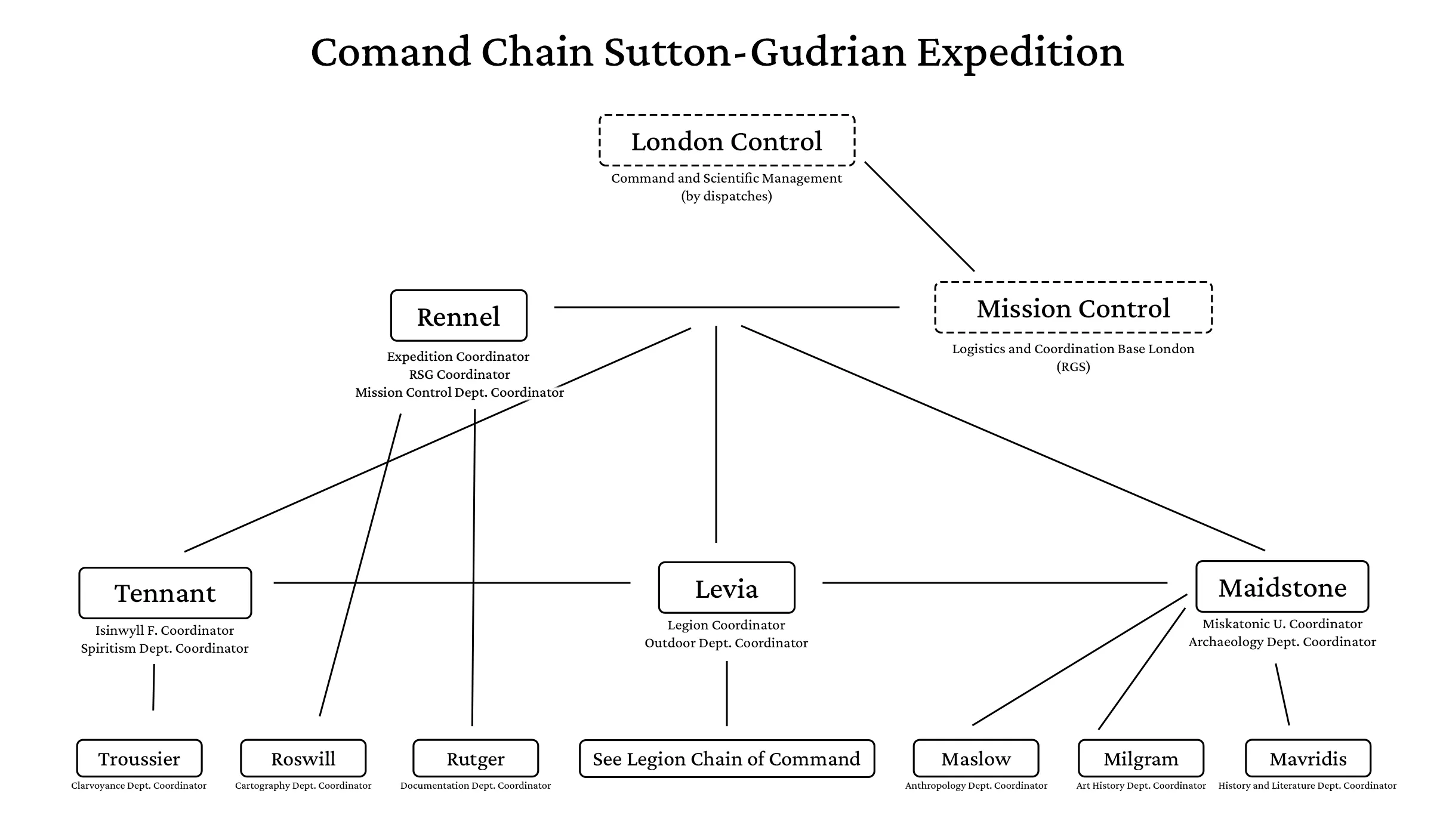

Miskatonic University
Motto: Ex Ignorantia ad Sapientiam
It needs no introduction. Miskatonic University is the university based in Arkham, Massachusetts, and most of the academics participating in the expedition come from the ranks of this university.
The determination and scholarly ability of its professors will be decisive in gathering information about the archaeological and historical-linguistic aspects of the expedition.
The departments of which Miskatonic University is composed are three:
- Department of Archaeology
- Department of Anthropology
- Department of Art History
- Department of History and Literature
Anthropology Dept.
The members of the Department of Anthropology at Miskatonic University will be engaged in the study and interpretation of texts, rituals, and symbologies of ancient and contemporary peoples who, according to the documentation, have had or have to do with the city of Zerzura and the territory in which the mythical white city is thought to be located. Of particular importance will be the study of the Akkad Book of the Dead (Appendix I), the comparative study of the brief Essay on the Burials of the Ancient Saharan Populations by Professor Petkov, and the interpretation of an important photographic testimony.
The Anthropology staff will also be involved, at their discretion and depending on the overall organization, in possible archaeological sub-expeditions outside the camp, in order to be present at any discoveries and to be able to detect important details during excavation operations.
The theories, hypotheses, and discoveries resulting from the interpretation of these sources will be of vital importance both for the process of knowledge that brings us closer to the city of Zerzura and, we hope, to acquire useful information for finding the Jefferson expedition, unfortunately lost.
Archaeology Dept.
The Department of Archaeology is the beating heart of the Sutton-Gudrian expedition. Its members will be primarily engaged in excavation sub-expeditions outside the base camp, in search of ancient artefacts that can bring to light from the sands of time the stories of the peoples who inhabited those places, in the hope of finally finding the way to the long-sought destination: the mythical city of Zerzura. Through their strenuous work and dedication, the archaeologists must also be vigilant in detecting any clue that could trace the lost Jefferson expedition in the sea of sand.
When not engaged in excavations, the archaeologists will also need to take care of the study, restoration, and interpretation of any finds uncovered during the excavation. Every discovery, every theory, and every significant detail will be communicated to the mission command contact person, who will ensure that the valuable information is circulated; each piece of the puzzle will bring the entire expedition closer to the vision of a broader picture, towards discoveries that could rewrite the history of archaeology.
Art History Dept.
The Department of Art History will be responsible for studying artistic artefacts that may reveal important clues about the history and location of the mythical city of Zerzura. The scholars will need to analyse and interpret both the artistic artefacts already in their possession and any others that might be discovered during the excavation works of the expedition, including jewellery and ritual ornaments.
Through their knowledge of art over the centuries, they will have to formulate theories about the affiliation, meaning, and stories that the various artistic representations tell us, traversing the centuries since their creation. Every detail must be reported to the mission command contact, who will take care of conveying the information and hypotheses of the department.
Members of Art History may also request to participate in the excavation sub-expeditions outside the camp to witness any discoveries firsthand, provided they ensure the fulfilment of the tasks assigned to them by London.
History and Literature Dept.
The Department of History and Literature will primarily be responsible for the study, translation, and interpretation of the cuneiform inscriptions contained in the artefacts already in the possession of the expedition and others that may be discovered during the research. Additionally, the History and Literature staff will be engaged in the study and analysis of texts or fragments of them concerning events that somehow have points of contact with the goal of the Sutton-Gudrian expedition, the search for the mythical white city of Zerzura.
The work of the Department of History and Literature will be of fundamental importance for understanding the messages that ancient peoples have left us as a testimony of the stories of a glorious past that awaits only to be brought back to light. The members of History and Literature must be diligent in sharing their discoveries with the rest of the scholars through their mission command contact, who will be responsible for circulating the valuable information found.
Members of the Department of History and Literature may also request to participate in the excavation sub-expeditions outside the camp, ensuring in any case the fulfillment of the valuable translation task assigned to them.

The Legion
Motto: Courage and Honor
They are an international paramilitary force with many operational missions in the desert and in hostile territories behind them. They are adventurers capable of getting out of the most complicated and desperate situations thanks to their great experience in the field.
Although they have a dubious reputation as mercenaries and opportunists behind them, their contribution to the expedition in terms of support will be crucial for everyone’s survival.
The Departments of which the Legion is composed are two:
- Department of Outdooring
- Department of Medicine
Legion’s Chains of Command
The Legion is a military organisation with a hierarchical structure and chain of command. Levia, who has the highest rank, coordinates both the Legion and the Outdooring department, with Lithgow, Lebon and Lionidze as his lieutenants. The medical department is coordinated by Lister, a lieutenant, and his second lieutenant, Leander.
During the expedition, if an officer can no longer serve, he is replaced by the highest ranking officer. If all officers are unable to serve, the soldiers choose a new leader from among themselves through a vote. If the officers do not reach an agreement, the soldiers may vote. Leadership decisions must remain internal to the Legion.
If an officer loses the ability to serve, he is demoted but must continue to contribute to the mission.
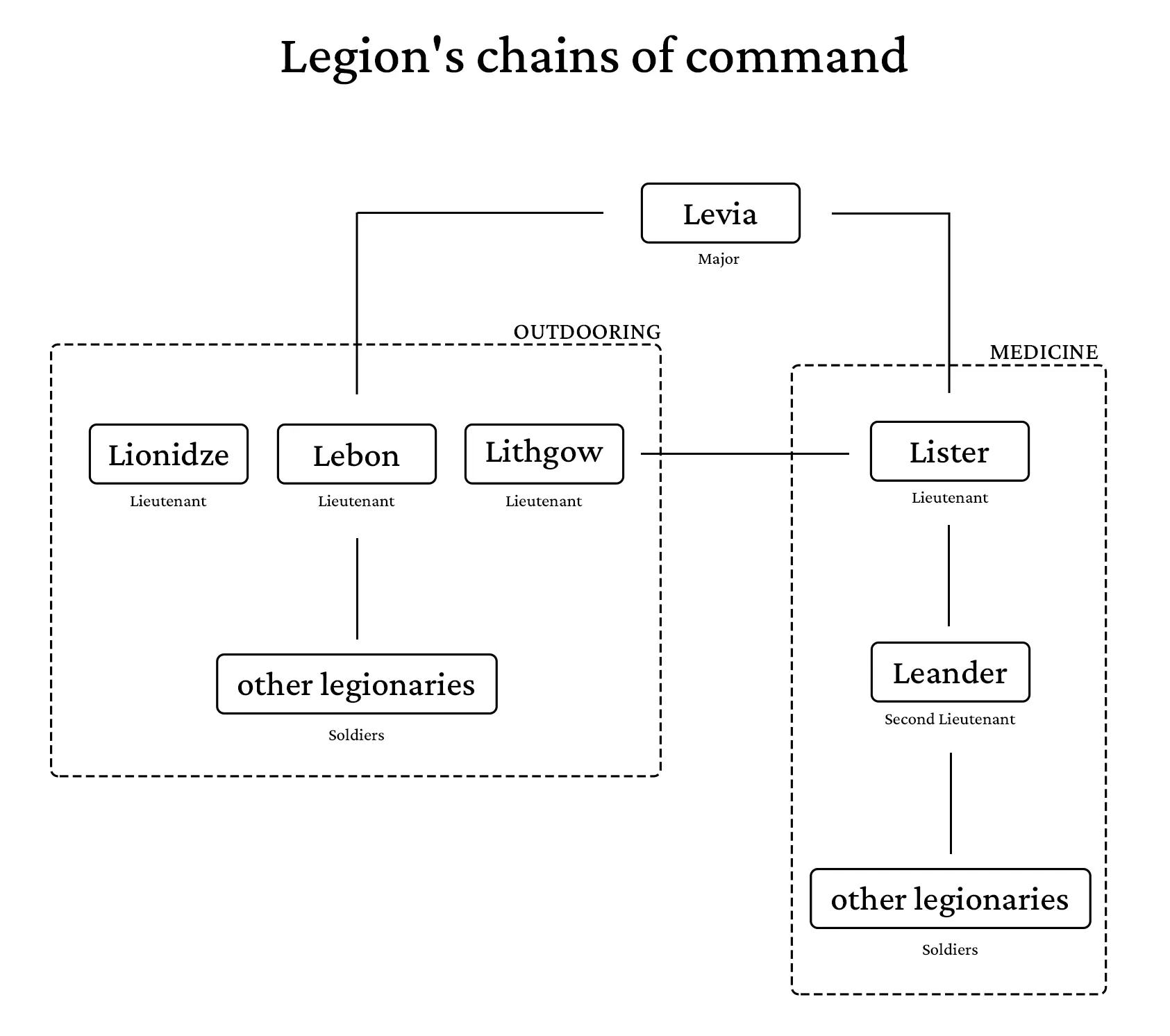
Medicine Dept.
The Department of Medicine of the Legion is responsible for ensuring the psychophysical health of the Expedition’s members, monitoring individual health and administering therapies when necessary. The Department of Medicine also monitors for the presence of any local pathogenic agents that could jeopardize the mission’s success, including conducting laboratory analyses on any biological finds, and through the analysis of medical treatises. Concerning medical situations, discoveries of medical dangers, or other relevant medical facts must be reported to the senior officer in command of the Department and from there to the Mission Command liaison staff. The same applies to any reports regarding assignments provided directly by the London Command.
Outdooring Dept.
The Outdooring Department of the Legion is responsible for the safety of the expedition members, ensuring they face as few internal or external dangers as possible. The Outdooring operators are also in charge of escorting scholars out of the camp during any archaeological or study sub-expeditions and coordinate logistical needs, such as the preparation and management of the entire expedition’s movements.
Any sighting or finding made during the activities requested by London or in normal service must be reported and/or delivered to the department’s commanding officer and from there to the Mission Command liaison staff. The same applies to any reports regarding internal investigations requested by the London Command.

Royal Geographical Society
Motto: Knowledge is Power
The long-standing British geographical association has a solid background of ambitious expeditions by explorers who have entered into legend.
Its cartographers and expertise in managing expeditions into hostile territories will be crucial to the success of the expedition. Furthermore, the command and logistics of the entire mission is managed by them.
The Departments of which the Royal Geographical Society is composed are three:
- Department of Cartography
- Department of Documentation
- Department of Mission Command
Cartography Dept.
The Department of Cartography of the Royal Geographical Society is responsible for ensuring that the Sutton-Gudrian Expedition navigates through the desert and achieves its goals: to locate traces of the Jefferson Expedition and to reach Zerzura. It will be required to chart routes and identify safe paths in collaboration with the Outdooring Department of the Legion. The Department of Cartography is also tasked with analyzing maps and historical geographic charts to support and corroborate study hypotheses and identify potential excavation sites, also utilizing photographic materials collected by the Royal Geographical Society.
Cartographers will also be able to dedicate themselves to the study of archaeological finds related to maps or places, as well as participate in archaeological sub-expeditions to ensure precise documentation of potential excavation sites.
Documentation Dept.
The documentation department will be tasked with producing a sound film documentary that tells the epic adventure of the Sutton-Gudrian expedition and its members. The crew will consist of emblematic figures necessary to manage various aspects of a set: direction and assistant direction, acting and narration, screenplay, scene photography, and shooting.
The documentary will have to focus on two fundamental aspects: narrating the discoveries, the difficulties, and the journey of the expedition through interviews with members of other departments, and attempting to reconstruct and narratively divulge the ancient stories hidden under the desert sand which, we hope, will gradually be brought to light. How did the ancient inhabitants of these areas behave? What did they believe in? How did they perform rites of passage? These are the questions that the documentarians will need to try to answer.
For this reason, the documentation crew must be ready to capture the key moments of the expedition, from excavation missions to meetings during operational sessions, to documenting also more intimate and personal aspects of other members, respecting everyone’s sensitivity.
The documentation department will have access to cutting-edge equipment and anything needed for shooting, from film development to production plan modules.
Mission Command Dept.
The Mission Command is the main decision-making and organizational body of the Expedition, in compliance with the assignments from the London Command. It will handle the distribution of assignments to the various Departments for each operational session and receive from each Department the report at the end of the session, preparing a complete and summary report that will be sent to the London Command, always at the end of each operational session.
The Mission Command also has the responsibility of making decisions regarding the management of the camp – from a logistical point of view and also from a disciplinary perspective, if necessary – collecting and evaluating requests and proposals from the institutions that make up the Expedition. As an on-field tool of the London Command, it may be called upon to make decisions regarding the Expedition in general, especially in cases where communication with the London Command is suspended or impossible.
The Mission Command, composed of experts in scientific and organizational fields, will also have the responsibility of coordinating the circulation of information among the various Departments and Institutions that make up the Expedition, providing an overall analysis of the collected information and looking for connections, where possible, between this information.
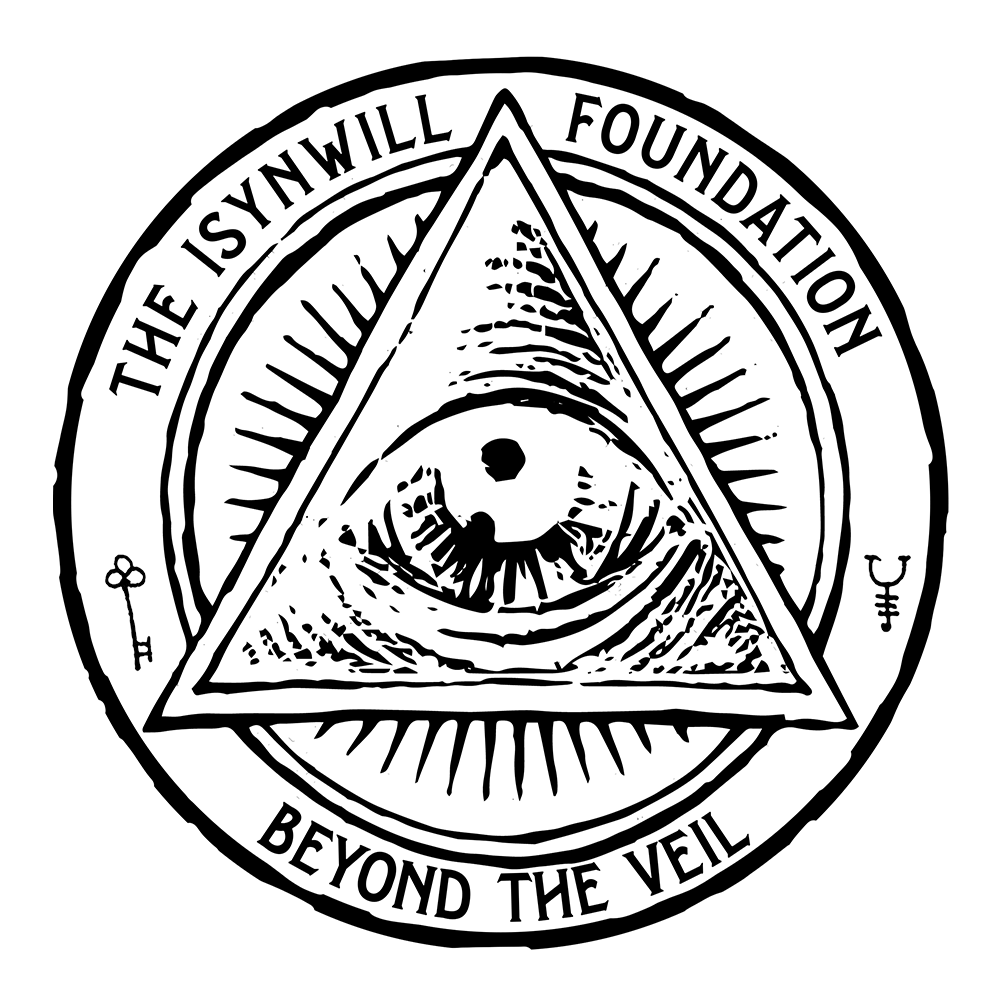
The W. Isynwill Foundation
Motto: Beyond the Veil
The W. Isynwill Foundation has been involved in parapsychology and the investigation of reality with “alternative” and experimental tools and techniques for many years. Their long experience in the field and the undoubted successes they have achieved have granted them a fair reputation throughout the United States.
Despite this, many remain sceptical of their methods. However, their scientific and para-scientific background is indispensable to give the expedition an extra edge.
The departments of which The W. Isynwill Foundation is composed are two:
- Department of Spirtism
- Department of Clairvoyance
Clairvoyance Dept.
The members of the Department of Clairvoyance will be responsible for performing Astral Travels through which they can access other planes of existence. Astral Travels are carried out through delicate and demanding rituals that involve the participation of all the department members. Each Journey includes a preparation phase in which the location where the ritual will take place is carefully arranged. Travellers cannot and must not be interrupted during the Journey and must be kept at a safe distance from the camp to ensure the necessary tranquillity and concentration.
Astral Travels is not an exact science and can hide surprises and pitfalls, providing glimpses of truth about the past, present, and future of our and other realities. Therefore, a subsequent phase of analysis of what was experienced during the journey will be necessary; every detail, every suggestion or intuition can be crucial in uncovering clues about the disappearance of the Jefferson expedition or the path towards the coveted white city: Zerzura.
Spiritism Dept.
The Department of Spiritism will be responsible for conducting special séances to try to intercept spirits travelling through the desert. These spirits are often divided into multiple fragments and communicate through the body and voice of the Mediums. In each session, the mediums are possessed by different fragments of the same spectrum, while other spiritists ask questions to the mediums, seeking the best way to interact with them without angering or causing them to flee before they have provided the valuable information they possess.
Séances are a well-established practice that has already provided evidence of its effectiveness in the past, but it is not without risks because every spirit is an enigma and could represent a danger to the safety of the spiritists. Spirits can be of various natures, ancient or young, friendly or hostile, but all can reveal startling truths from the beyond, information that could be crucial for the Sutton-Gudrian expedition: to search for the missing members of the Jefferson mission and to find Zerzura, the mythical white city.
Metatechniques
In Sahara Expedition we will use some narrative tools that we have designed specifically for this event. They are called “meta-techniques” precisely because they allow you to reflect on the story and intervene in its unfolding in a direct way, carving out a specific space for your character in the flow of events.
Their purpose is very simple: to go straight to the point of the relationships and emotions that interest you the most. They will be explained in detail during the workshops that will be held before the start of the game, but it is useful to start familiarising yourself with their potential.
Chapters
Sahara Expedition is divided into five chapters plus a prologue, each lasting several hours. They are intended to make the action more dense and emotional by emphasising turning points in the story and helping you to evolve the story and your character. They will serve to simulate the passage of time, deepen interpretations and help you understand themes and interactions. They will be creative pauses from which to start again with greater intensity.
This metatechnique will be deepened during workshops before the start of the game.
Descent (Into madness!)
Dealing with the Cthulhu Mythos comes at a cost. The Descent is the narrative tool that tells how your character gradually loses contact with reality. At a certain moment your character might “lose control” and start to behave a little… crazy.
On your character sheet you find a section where you are given hints on how to interpret your character’s descent into madness. It is different for each character, some will relive past traumas, others will behave strangely…
We recommend that you link your Descent to the way you play your character. Remember, Descent is a track designed to help you. If you prefer to stage your Descent in a different way to what is in your sheet, you can do so, the important thing is that you remain true to your character. If you have any doubts, please contact us.
This metatechnique will be explored in depth during workshops before the start of the game.
Costumes
You will be playing in a particular, unique environment, and it is important that in addition to an evocative and charming costume, the clothes must also be practical, especially footwear.
Mild Climate
Although in the imagination the desert is hot, in reality this is not always the case. We purposely chose periods when the temperatures are mild and range between a minimum of 14 °C and a maximum of 26 °C. So it’s super comfortable!
Let’s avoid clichés
An exploration mission may bring to mind images of Dr Livingstone or typical Berber clothing. Keep away from the obvious solutions so as not to make your character a stereotype. No tropical (colonial) helmets and no ethnic clothing.
Clothes and accessories must tell the story of the character, their life, their personality, and remember that each Institution has its own colour.
Colours and Materials
Being able to recognise who is in front of you at first glance will be an added value to your gaming experience. It is possible to trace the Institution a character belongs to from the initial of their name, which is identical to that of the Institution itself, but it is not always easy to remember so many names: this is where costumes come in, allowing you to recognise a character’s affiliation at first glance, from their colour and style.
The colours indicated do not necessarily have to be dominant in the character’s costume: the fashion of the time, especially for men, tends more towards neutral tones. The important thing is to manifest the colour of one’s own institution in at least one accessory and to avoid the colours of other institutions as much as possible.
- Miskatonic University – Red
- La Legione – White
- Royal Geographical Society – Blue
- The W. Isynwill Foundation – Yellow
Institutions – Styles
The style of the characters’ clothing is not so much a constraint as it is a matter of shared taste that each person can interpret in their own way.
In the list below you are given a concept to inspire you, while following the descriptions of each institution we will proceed with a series of pictures and practical examples to achieve the desired result (feel free also to consult the gallery of the previous runs to get an idea).
- Miskatonic University – Academic
- The Legion – Military (Jacket and hat will be provided by the orga)
- Royal Geographical Society – Practical/Technical
- The W. Isynwill Foundation – Extravagant
Miskatonic University
The characters of Miskatonic University come from a formal and privileged background.
Adherence to etiquette and professorial style is important, so it is not uncommon to see them in the desert wearing jackets with patches, classic trousers, cardigans and waistcoats, as well as shirts or blouses, also with cardigans and jackets, as well as with skirts and high-waisted soft trousers.
Ideal accessories for showing off the colour red are ties, bow ties, fedoras and caps, or scarves and cloche hats.
The Legion
Legion members follow a less strict protocol than a national army, but still a form of uniform. A white jacket and hat are provided by the organisation, while it is customary to wear a white shirt and white trousers, either long or knee-length, with white or neutral coloured socks underneath.
In their case, accessories do not serve to show the colour of the institution, also because they are mostly made of leather or similar: belts, holsters and saddlebags, as well as white scarves.
Royal Geographical Society
The characters of the Royal Geographical Society know well what kind of business awaits them and they undoubtedly choose substance over form.
It is easy to recognise them by their light-coloured shirts with rolled-up sleeves with zouave trousers and work jackets or long coats. They usually avoid the constraints of ties and bow ties, preferring blue scarves and foulards, as well as braces and fedora or panama hats.
The W. Isynwill Foundation
The characters of The W. Isynwill Foundation are often eccentric and do not hesitate to show it off. Some dress elegantly in tailcoats or long dresses, others combine bold patterns, others display tabards or old-fashioned overcoats.
Handkerchiefs, headdresses, even exotic ones, as well as pendants or esoteric symbols if appropriate to the role, are the ideal accessories for flaunting the colour yellow.
Evening (Gala) outfit
If you wish, you can bring a change of dress for the gala (evening). The fashion of the time dictated a straight dress with barely noticeable or directly formless shapes as women’s clothing. Gloves were mandatory. Often the neckline was not on the breast side, but towards the back. All had a decoration on the head, such as a ribbon, a bow or a small tiara for the wealthy.
Men’s clothing was an elegant black suit and, for those who wanted to make their social detachment felt, a white waistcoat and matching white scarf.
It was not uncommon, however, to find women dressed elegantly as men.
The Explorer Kit
We have designed an “Explorer Kit” containing some clothing accessories that are suitable for all Institutions and characters and provide a nice (and comfortable) addition to your costume.
The Explorer Kit includes a traditional Saharan cloak (Bournous) that is used in every season, beautiful to look at and perfectly “explorer-style”, with an embroidered Sutton-Gudrian expedition patch and a Shesh, a “long scarf” also typical of the desert that can be used as a headdress or as a neck warmer.
The Shesh will be provided to each player in the colour of the institution to which their character belongs. It is delivered directly at the game location. The Explorer Kit is made by Tunisian artisans, the production chain is non-exploitative and fairly remunerated.
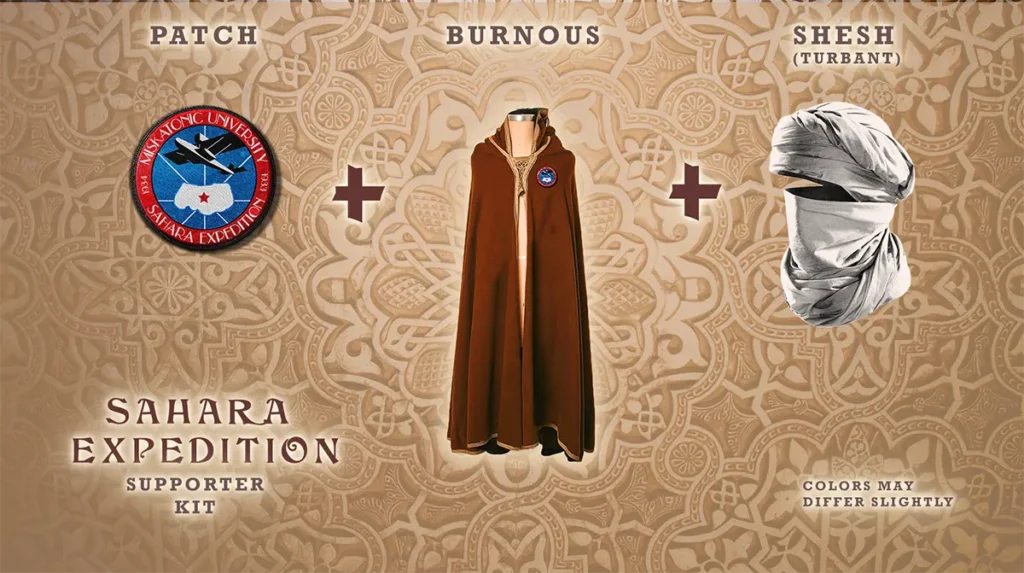 get your explorer kit
get your explorer kit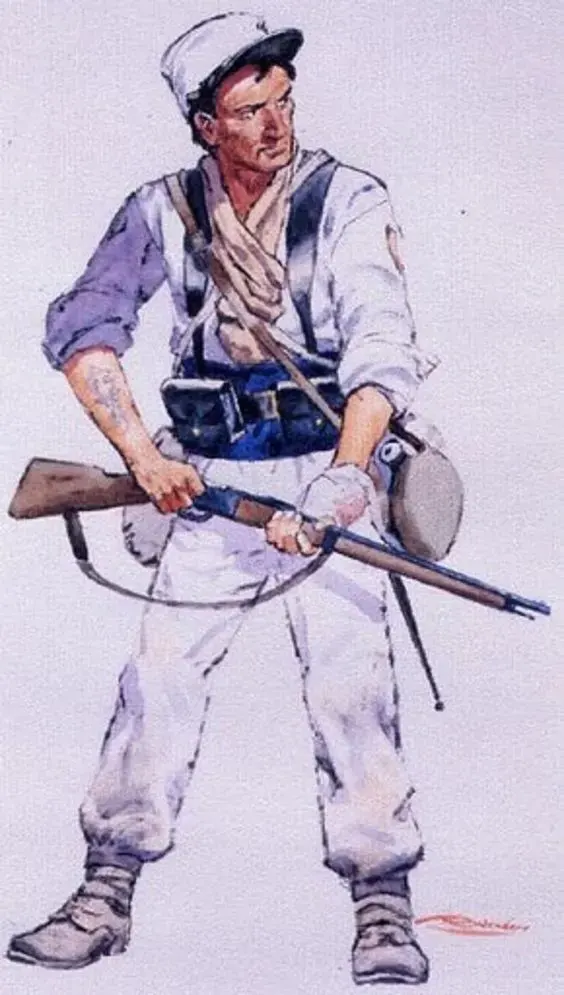
The Legion 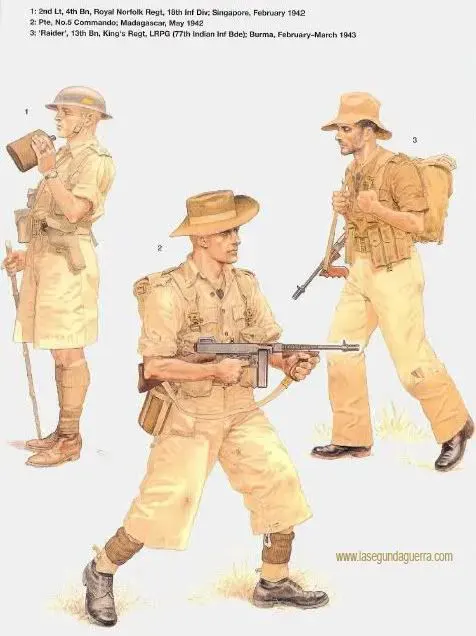
The Legion 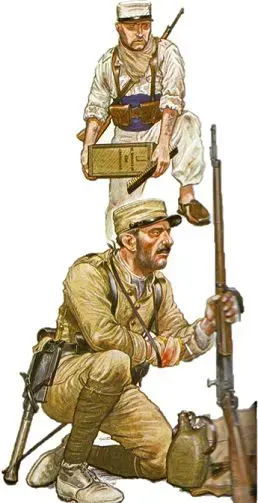
The Legion 
The Isynwill Foundation 
The Isynwill Foundation 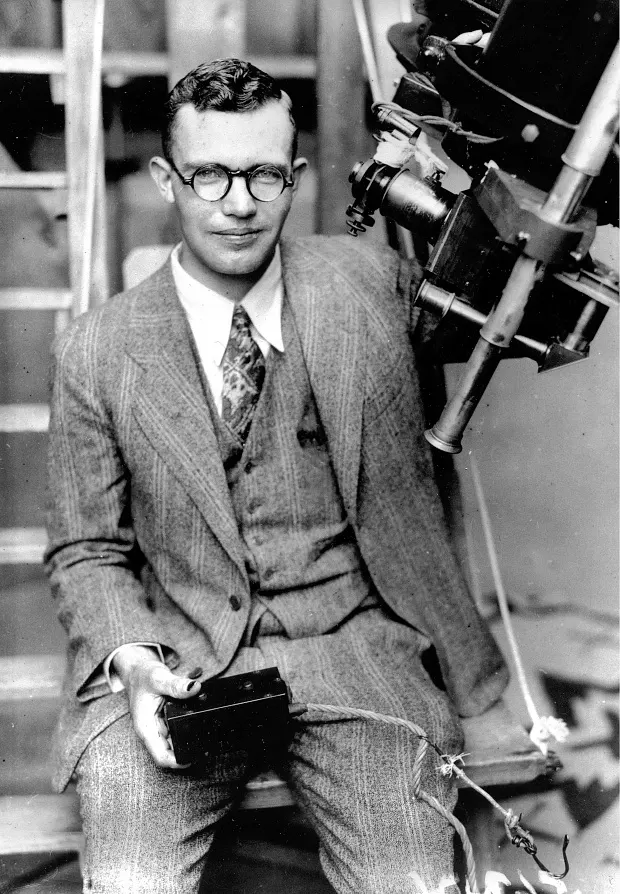
The Isynwill Foundation 
The Isynwill Foundation 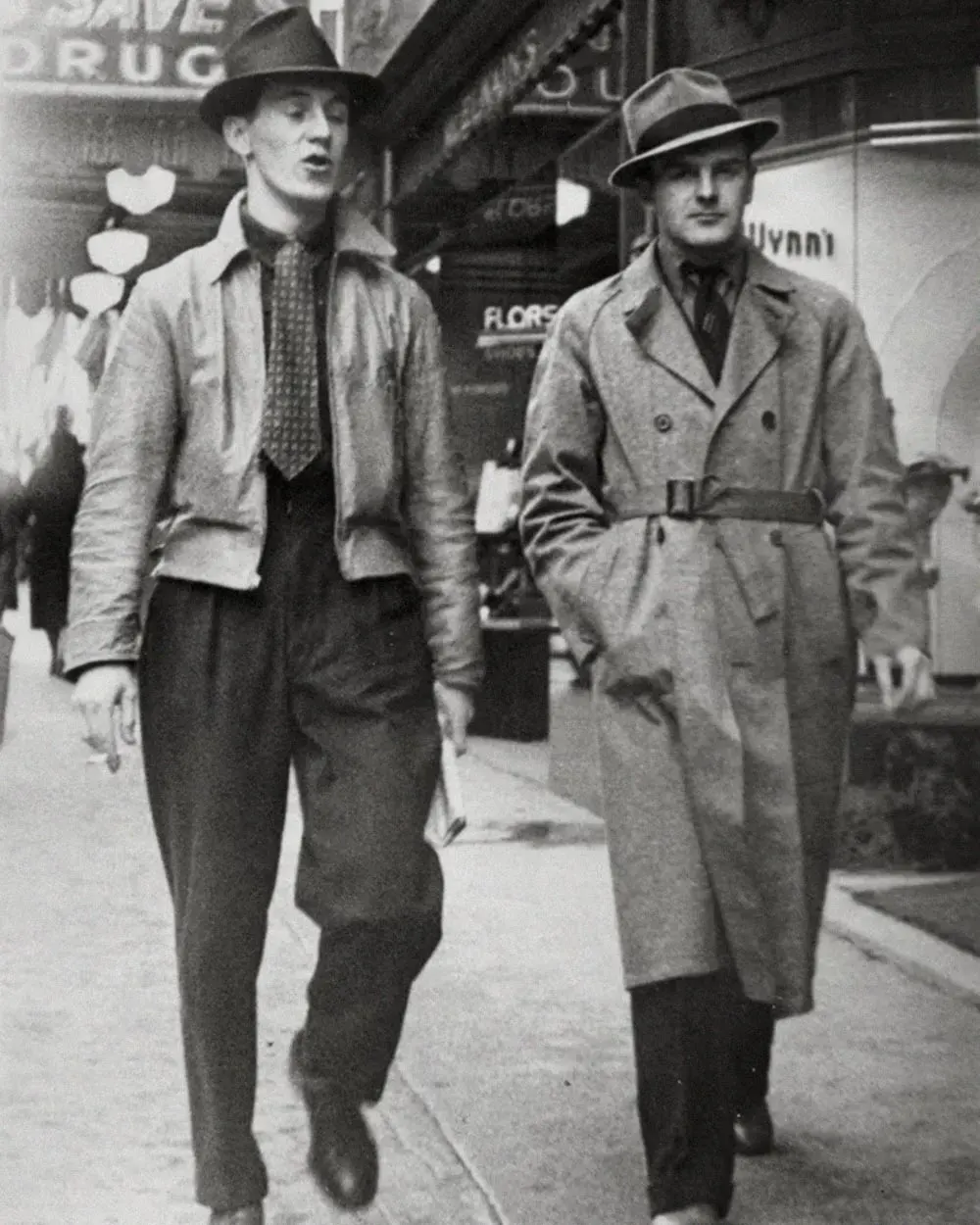
The Isynwill Foundation 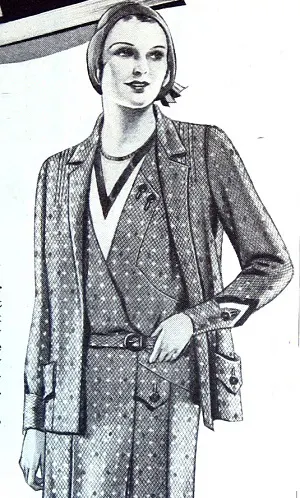
Miskatonic University 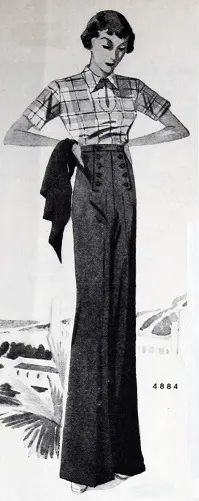
Miskatonic University 
Miskatonic University 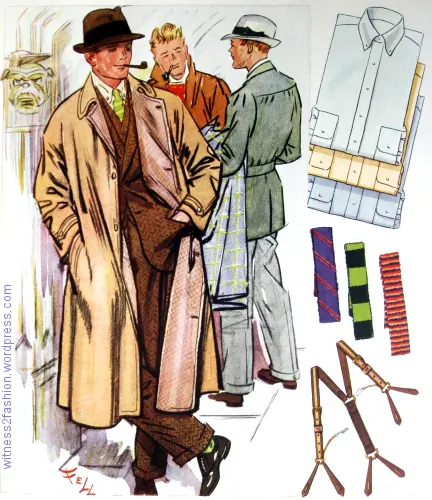
Miskatonic University 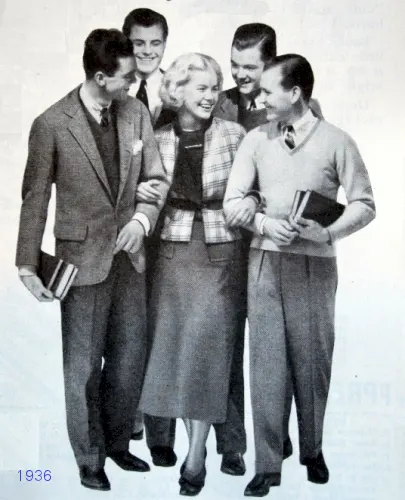
Miskatonic University 
Miskatonic University 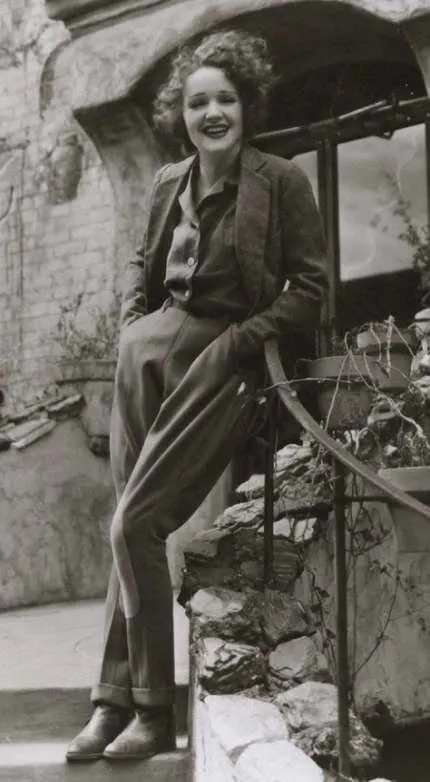
Royal Geographical Society 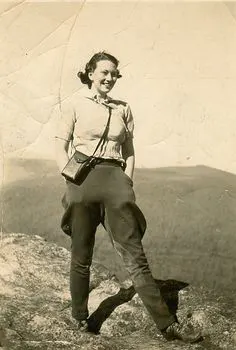
Royal Geographical Society 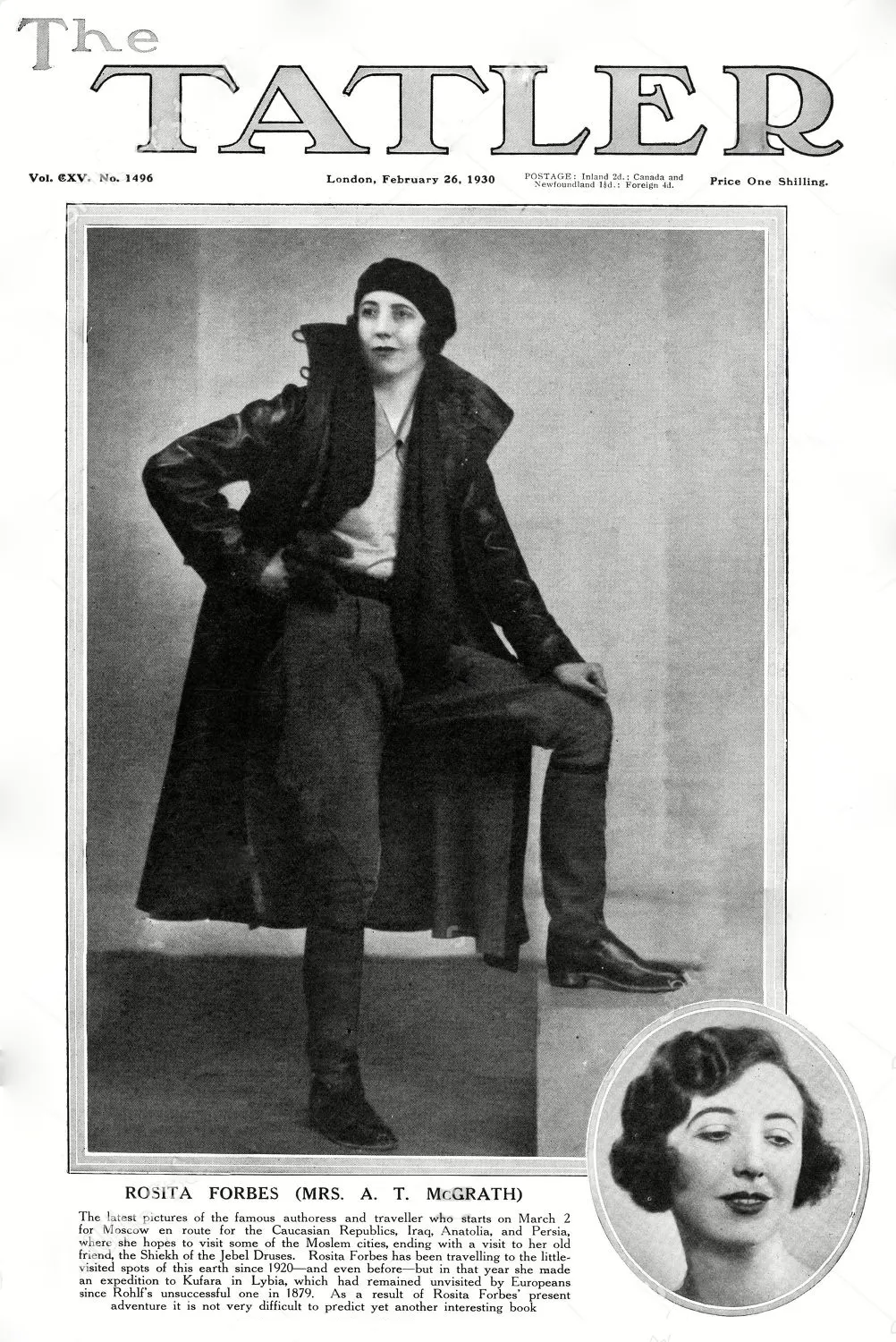
Royal Geographical Society 
Royal Geographical Society 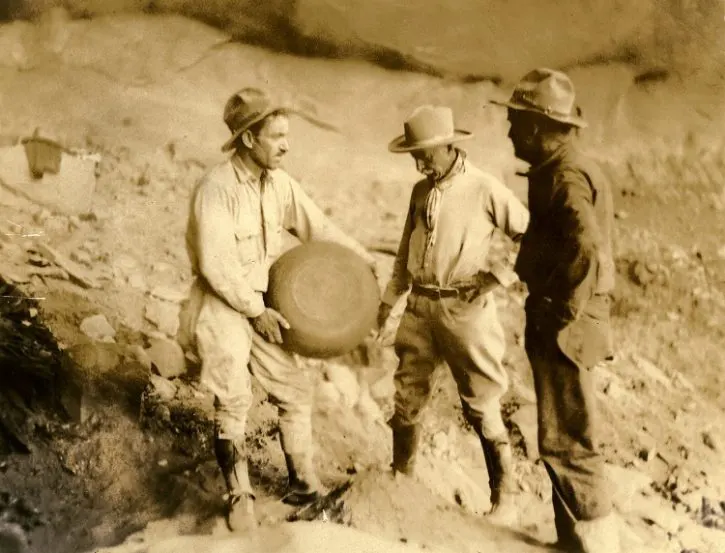
Royal Geographical Society 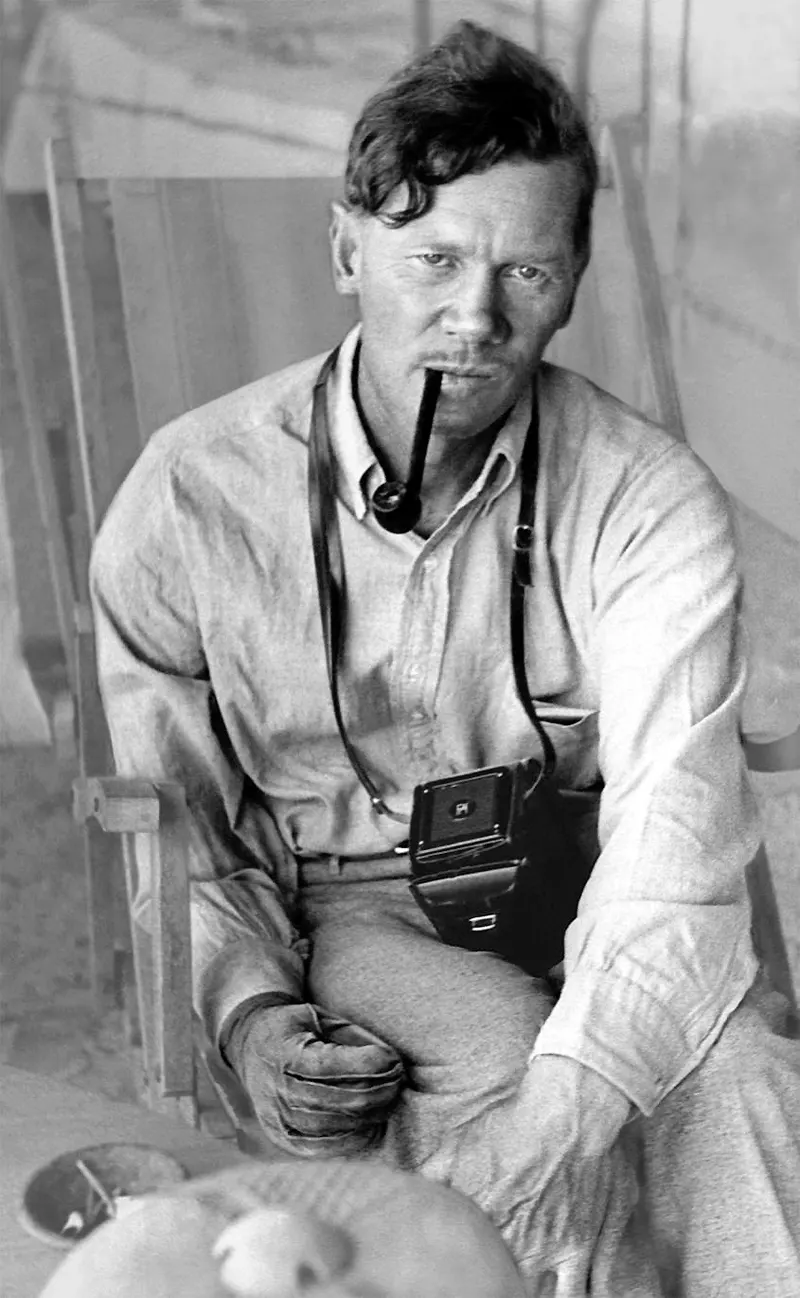
Royal Geographical Society
Characters
Casting
Before the start of the Larp, you will receive a form where we will ask you to indicate the 7 characters that intrigue you most. Once your preferences have been collected we will cross-reference all your indications to assign you your favourite characters. When the casting is complete we will inform you on the Larp channels (email, Discord, WhatsApp, Telegram, and Facebook).
There are no less than 84 characters to choose from, each one special and unique. We wrote and designed them with great love. But we know that reading them all can be challenging, so here are some tips for making your choice.
Archetype
Let yourself be inspired, follow your instincts. If some archetype intrigues or stimulates you, then make a note of it. It is an excellent starting point because it contains the essence of the character in a single sentence.
Trigger
Some characters have had complicated and perhaps painful histories. Take a look at the character triggers to see if you want to discard some of them because you prefer not to deal with certain issues.
Institution and Department
Each character belongs to an Institution and a Department, and will have specific tasks within the Expedition, which will give you a general idea of the type of game the character proposes.
Remember that you do not need to be an expert on your character’s task: the procedures are designed also to allow anyone to perform a task in a functional and credible manner!
Read the full sheet
When you have narrowed down the shortlist with the criteria of Archetype, Institution and Trigger Warning, then read the whole character. At this point you can go deeper.
Genderless
All characters are freely playable in relation to gender and have been written specifically with this in mind. So you can rethink the relationships on the character sheet according to the gender you prefer to play.
We imagined a world in which each profession and social role was also open to women. We chose to disregard historical allegiance in favour of an inclusive game open to all. This means that gender discrimination and misogyny will not be themes in the game. However, this does not apply to other types of discrimination linked to other identities and stigmatised characteristics: you will find evidence of these in the individual triggers of the characters who are victims.
Transparency or Spoiler?
Character sheets are “transparent” and public, which means they have no secret parts. Why? Because Sahara Expedition is a choral story that is built together, never against. Although secrets and conflicts will not be missing, they are always part of the fiction and rely on your interpretation and ability to create stories. With this choice we believe we make this point even more central. We also don’t want to put players in the position of choosing a character they don’t know everything about, the characters offer different experiences depending on the themes they are related to. We want all our players to know the nature of a character before they can choose them.
If you prefer to know only the bare minimum about your character, you can avoid reading the character sheets of the characters to which yours is related. This way you can keep some “mystery” about certain aspects of the character’s life.
Fill in the blanks
When we designed the characters for Sahara Expedition, we wanted to create a structure that would ensure a stimulating experience integrated into the story. But we also wanted it to be free enough to allow everyone to “fill in the blanks” and make their own interpretation unique. In addition, having room to customise your character will make it easier for you to feel comfortable in their shoes. The parts that you find written in the character sheet should be considered “immutable”, but anything that you do not find in the sheet (e.g. what you did at a certain time in your life, what your favourite food is, etc.) you can decide for yourself.
Get to know the character
The characters in Sahara Expedition are deep, multifaceted, each one unique in its own way. They are characters of their time. That is why you will find quite precise historical, social and political references in many of them. When you encounter these themes, we advise you to delve deeper, perhaps by searching in books or on the web, so as to really understand the essence of the character. Try to understand what they are passionate about and why, in what atmosphere they grew up. This will give you a very strong push to interpret them and will immerse you even more in the mood of the 1930s.
W-A-Y
In the character sheets, you will find references to extras that will never appear live during the game. You will recognise these extras because their names and surnames always begin with one of these three letters: W, A, Y.
Go to the page containing all the characters. To log in, you will be asked for a password that we have sent you by e-mail. If you have any doubts, please contact us.
The Character Sheet
In Sahara Expedition there are no minor characters, each one has its own specificity, each one is a fundamental piece of the mosaic. There are no extras, only protagonists.
We imagined each Character’s Sheet as a literary tale in pure Cthuloid style. Each tale is divided into three chapters, the first tells of the character’s childhood and adolescence, the second of their adulthood, and the third of their days before they join the Sutton-Gudrian Expedition.
The sheet consists of several sections.
Surname
During the larp, only the characters’ surnames will be used. The initial of the surname is the same as the Institution to which it belongs. It is a little trick that will help you in the game to understand who you are dealing with:
M > Miskatonic
L > Legion
R > Royal Geographical Society
T > The W. Isynwill Foundation
Archetype
It is a short sentence that sums up the main character traits.
Trigger
Here you will find a short list of themes involved in the character’s story that may be sensitive. This way you can tell at a first glance if that character has to do with themes you would rather not deal with.
Roles
Operator
Most characters have this role, which means that they have no responsibilities other than to do their job well.
Department Coordinator (one in each Department)
These characters are responsible for coordinating tasks within the department.
Institution Coordinator (one in Each Institution)
These characters are responsible for coordinating and managing all members of the institution.
Expedition Leader (Rennel)
He is responsible for settling disputes and presiding over the Mission Command.
Character Breakdown
This section of the Character Sheet is made up of concise hints to help you understand and deepen your understanding of the character. It is a kind of super summary that helps you see the character more analytically and imagine some of the game dynamics they will be involved in. In the Character Breakdown, you will find several sections.
Personality
Here you will find a brief description of the character’s way of being and some indications that will help you to enact their personality.
Relationships
You will find here some possible interactions with other characters that your character has encountered in the course of their life. Here you will also find hints and tips on how to handle these relationships. Remember that before the start of the game there will be a workshop to help you better define your relationships directly with other participants.
Questions
In this section, you find the ethical, existential, and moral questions the character is trying to answer at this time in their life. During the game, try to answer these questions.
Descent (into madness!)
In this section of the Character Sheet, you will find how your character experiences their descent into madness. See the Metatechniques section to learn more.
Tasks
The tasks are a list of ‘typical’ character activities. It is only a suggestion and is not exhaustive, but it can help you understand what their routine is and what things are expected of them.
Logistics
What to bring
Food and accommodation from your arrival in Douz is included in the registration fee. Regarding your stay in the hotel, the standard kit that you find in every hotel (sheets, blankets, pillows, pillowcases and towels, soap and shampoo, hairdryer, etc.) is included, whereas for your stay in the desert they will not be available.
We therefore recommend that you have with you:
- Your game costume (see Costumes).
- Personal belongings (towel, toothbrush, wet wipes, etc.).
- A sleeping bag.
- one backpack with a maximum capacity of 50 liters, consistent with the 1930’s style for the desert part of the game.
- OPTIONAL: A second elegant game costume for the prologue scene.
Travel documents
To travel to Tunisia you need:
- Passport.
Rooms
All hotel rooms are doubles, while the tents accommodate between 2 and 8 people (depending on the tent). It will be possible to recommend a roommate for the overnight stay in the hotel, using the form we will send you later, and we will do our best to accommodate your needs.
Food
The food will be cooked by the hotel staff and the camp chef. Vegetarian and vegan options are always on the menu. If you have any allergies you can report them in the form we will send you.
Luggage
During the desert expedition, you may only carry a backpack with a maximum capacity of 50 litres and your worn game costume. The backpack must be “in style” and we advise you to keep it as light as possible. The rest of everyone’s personal luggage will be left at the hotel and will not be accessible during the days when we will be in the desert.
